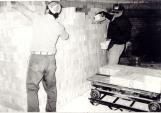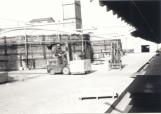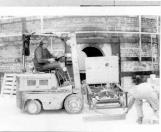1
Welcome to theEric Neiswandt story
3
Eric Nieswandt StoryEric was born in Germany and came to Canada in 1927 with his mother and father when he was only a few months old. The family had friends at Avonlea as well as a brother who encouraged them to come to Canada, however, Mr. Nieswandt's brother drowned in a slough in the hills before they arrived. They rented the farm just south of Claybank and later bought it. Eric learned English from the Nuns at Claybank School, which he attended through grade 8. He stayed home to help his Dad with the farming and at age 17 worked for the CNR for a couple of years. He started at the Brick Plant in 1947 but had to quit in the fall to help with harvest. In the spring of 1948 he returned to the Plant and continued to work there until a few months after it closed having put in 42 years of continuous and dedicated employment. When the Plant closed he was kept on to fill the remaining orders and loaded cars in -40 degree weather.
When Eric started at the Plant he was making 59 cents an hour, working 44 hours per week shift. His first job was unloading slack coal which was shipped in by rail, to burn in the kilns, a "dirty, dirty job". When finished he was allowed 15 minutes to shower in the bunkhouse. There was no easy jobs at that time, everything was done by hand. After that he wheeled brick and was paid by the ton "a little more profitable". The wheelbarrows of brick were wheeled from the kiln to the shed where they were stacked or put directly into a rail car for shipping. They were stacked by hand and for shipping; straw was put between each layer of brick. The sheds at that time were open with just a roof overhead and you had to shovel snow before you could wheel bricks in. The thick grease in the wheel made it hard to push, and occasionally a fellow worked would jokingly toss a piece of 2x4 in front of the moving wheelbarrow, tipping the bricks out. In the 1970's they got a fork lift and shrink wrap machine. Bricks were picked up on a pallet from the kiln, wrapped with plastic and popped into the shrink wrap oven. A big improvement, but sometimes the cold air when loading a car would cause the shrink wrap to split and it would have to be done again.
At the time Eric started at the Plant, there were over 60 employees and when it closed there were only 13. Eric walked a short distance across the hills to work and often had lunch in the bunkhouse. You couldn't miss a days work or it would interrupt the production line. A good game of cards was often enjoyed in the evenings at the bunkhouse if you had to stay over.
In the 1950's, Elaine came to Claybank from B.C. with her Mother and Dad, Vince and Beth Dombowsky, who had bought the store from Mr. Jelinski. Elaine and Eric were married in 1959 and lived on the farm until moving into Claybank in 1974. They raised a family of three; Rod, Nancy and Janice. Rod worked at the Plant during the summer months and on weekends in the lab while he attended the University of Regina. Eric and Elaine retired into a new home in Avonlea in 1990. All in all, Eric said "he enjoyed working at the Plant" and has many good memories of his days there.
4
Palletizing brick inside a kiln 1974, left is Wilfred Harlos and right is Eric Nieswandt.1974
Claybank Brick Plant Site

5
Eric Nieswandt driving the forklift with a load of palletized brick from a Kiln.1980
Claybank Brick Plant Site

